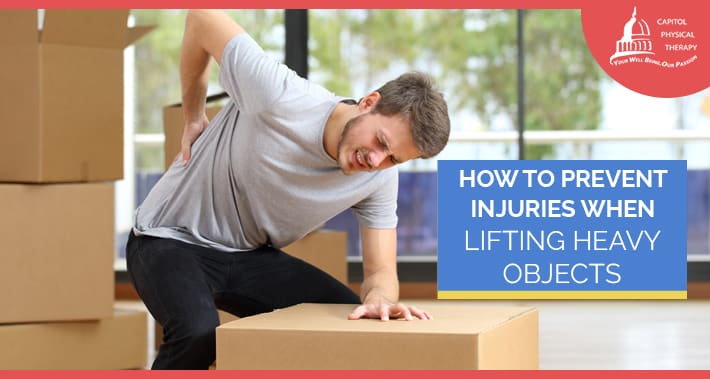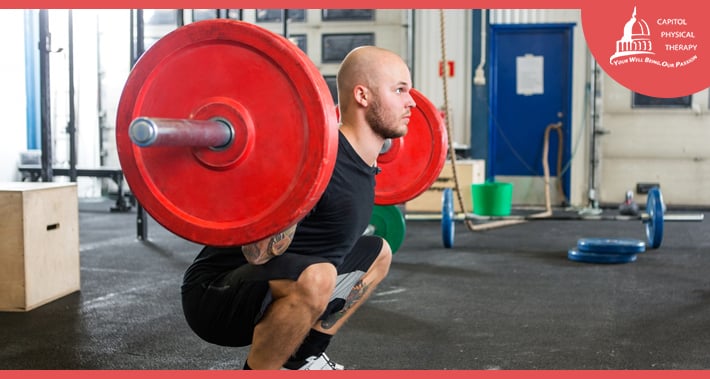
There are two common places where you’re most likely to lift something heavy.
One is at work – injuries from lifting heavy items are one of the leading causes of workplace injuries in the US.
The other is at the gym.
While proper form may be your focus at the gym, being more aware of the risks during your workout will help you avoid to injury and improve your fitness.
Some of the most common forms of injuries from heavy lifting are back and shoulder strains.
For most physical therapists who see people with workplace injuries, physical therapy and ergonomics go hand in hand, and part of your treatment plan will include giving you the knowledge you need to assess the ergonomic risks of your job.
Likewise, sports injuries from lifting can be avoided if you learn the correct way to do the heavy lifting.
Regardless of what you were lifting, or where you were when you were lifting it, physical therapy in Washington DC can help.
Let’s look at some of the most common injuries people experience, both at the gym and in the workplace, and the best ways to avoid this happening to you.
Common Injuries From Heavy Lifting
The Occupational Safety and Health Administration (OSHA) released a fact sheet with a list of the most common workplace injuries, stating that almost one third of all incidents involve injury to the shoulder or back.
Lifting, pulling, or pushing heavy objects can cause serious injuries to various parts of your body.
These injuries can be classified as traumatic (a break, pull or sprain) or overexertion (repetitive strain) injuries, and include:
- Lower back injury
- Shoulder injury
- Pulled muscles
- wrist injuries like wrist tendinitis
- Elbow injuries like tennis elbow
- Spinal cord injuries
Each of these injuries can cause chronic pain issues that may lead to an opioid prescription for pain management.
You should instead consider physical therapy both alongside opioids and as an alternative to them for chronic pain management.
Physical therapy is also an important step to recover from a repetitive strain injury or a traumatic injury.
But, we’ll dive more into how physical therapy can help later.
First let’s focus on prevention.
How To Prevent Injuries When Lifting Heavy Objects At Work
One of the best ways to avoid injury is to ensure that you have the tools you need to do your job.
Various ways to aid your heavy lifting may be available, such as:
- A forklift (with correct training) to move the heaviest objects
- Supplies that do not come packaged in weights heavier than 50 pounds
- Items well packaged on pallets that can be moved with pump trucks
- Pulleys or suction devices to aid movement
- Ramps to make transportation easier for pallets
It is the responsibility of your workplace to ensure safety procedures are in place, and to inspect the workplace regularly to keep all tools in good working condition.
But not all jobs can be done with larger tools to help you take the weight.
So here are some methods you can personally employ to keep yourself safe.
1. Plan What You’re Doing In Advance
Making a plan is always the best way to go about things, and in the case of moving heavy items, it will allow you to alleviate some of the risk.
Take a close look at the heavy thing you need to lift to decide whether it’s a one person job, or whether you will need to work in teams.
Give yourself enough time to complete each task, so that no one feels the pressure of doing things quickly, and incorrectly.
And don’t let anyone rush you, either.
Workplace efficiency is important, but your safety is more important.
2. Keep The Weight Close To Your Body
When you’re holding the heavy thing, keep it close to your body, not at arm’s length, allowing your whole body to take the weight.
Holding items further away from your body will put all the pressure onto your back and may cause a strain.
3. Plant Your Feet
Make you wear the correct footwear (don’t try to lift heavy items wearing sandals or heels!) and plant your feet when you lift.
Keep your feet hip width apart to balance yourself and take the weight in your core.
4. Bend Your Knees, Not Your Back
Your knees were designed for bending, and although your back can bend as well, your spine needs to be straight to support a heavy weight when lifting.
So when lifting something off the ground, squat before lifting, and focus on keeping your back straight as you lift.
Lifting with your back bent can cause you to need physical therapy for spinal issues.
Lifting with your knees bent has the possibility of injury as well, but the risk is much less.
If needed, rest the item on one knee as you stand.
5. Lift With Your Legs, Not Your Back
So now you’re squatting.
You’ve grabbed the heavy thing in the most effective way.
It’s time to raise it.
Use your legs.
Your leg muscles are much larger and stronger than your back muscles.
Using your back muscles to lift an item that is too heavy will cause a strain in your back, or it may go into spasm.
Use your leg muscles and glutes to lift as you rise.
6. Engage Your Core Muscles
Likewise, your core muscles stabilize your entire body, so be sure to engage the core muscles when lifting a heavy item.
Tighten your abdominal muscles (stomach) and keep them tight as you lift.
This will protect your spine from injury.
7. Keep Your Body Straight
Focus on moving in a straight line, both as you lift up and as you walk with a heavy item.
This will avoid putting unnecessary strain on one side of the body and allow you to use more of your muscles.
8. Keep Your Load Balanced
For the same reason as above, keep your load balanced and centered so that your whole body does the lifting.
Carrying a box under one arm, for example, creates uneven pressure on the spine, and could also result in a shoulder injury.
How To Prevent Injuries When Lifting Heavy Objects At The Gym
When you lift weights at the gym, you usually bear much more weight than your body is used to, in efforts to get stronger.
It’s important to focus on what you’re doing and to use good form at all times, or you may experience the setback of an injury.
Take a look here at four common exercises that you’re at the most risk of doing wrong.
Keep reading for some more tips to use when lifting heavy objects at the gym.

1. Always Warm Up First
For many people, the gym is something to squeeze in at lunch time or between appointments.
But no matter how limited your time, always warm up before you start your workout.
A ten minute run on the treadmill and a few stretches may be all you need.
This gets your blood pumping to the muscles joints you’re about to challenge.
A good warm up routine is essential for a healthy workout and will help you to avoid injury.
If you’re new to lifting weights, speak to a personal trainer to learn a good warm up routine.
2. Start With Lighter Weights
Bigger is not always better when you begin your workout.
Starting with lighter weights to get the feel of the movement will promote correct form and allow you to build into a larger weight as you create muscle memory.
Doing more reps at a lighter weight is a healthier way to work out and your body will thank you for it.
3. Follow The Right Form For Your Lifting
To follow on from the last point, if you lift too heavy a weight at any point, the first thing to go will be your posture, and injury could result.
Most gyms offer a free consultation when you first sign up, to give you an overview of everything available to you, but also to teach you the correct way to use the equipment.
Be sure to take advantage of this if you’re just starting out.
Taking a weights class is another way to learn how to lift correctly.
Learning the correct movements, and more importantly, what not to do, will save you from injury down the road.
As you lift, focus on proper form and posture, and don’t work out when distracted.
4. Give Your Muscles The Fuel They Need
Stay hydrated during your workout.
Good hydration equals healthy blood pressure and more support for your muscles as you use them.
Eating healthy foods or taking supplements to promote muscle healing is also important after a workout.
If you plan to lift heavy weights at the gym, then don’t put unnecessary strain on your body with an unhealthy lifestyle.
You can take a look at an article we wrote here for some more tips on how to relieve muscle soreness after working out.
Book Your Appointment With Capitol Physical Therapy Today
If you have experienced an injury due to heavy lifting, you know that the setbacks can be painful and frustrating.
A physical therapist will work within your limitations to get you back into top shape.
Your therapist will also provide you with the education you need to be aware of the risks in your environment, and help you avoid further injury.
Remember, it’s important to stick to your treatment in order to see the best possible results.
If you are experiencing pain due to injury, or if you would like to learn the best way to avoid unnecessary risks, we’re here to help.
Book your appointment with Capitol Physical Therapy today.
1331 H St NW #200,
Washington, DC 20005
- https://g.page/capitolptdc
9560 Pennsylvania Ave. # 202,
Upper Marlboro, MD 20772
- https://goo.gl/maps/zjL4NnnuThRhrcS86
Capitol Physical Therapy offers orthopedic and other pain related solutions, with our versitile team of physical therapists in Washington, DC